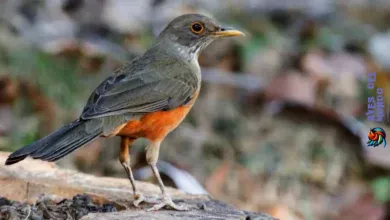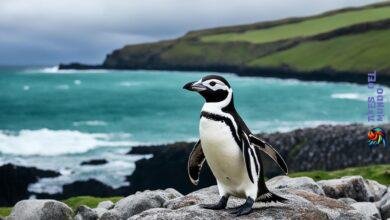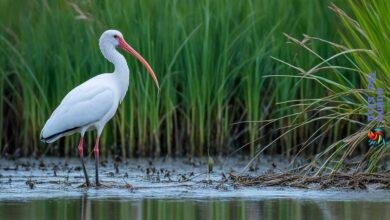Did you know Trumpeter Swans can fly over 3,000 miles during migration? They participate in North America’s annual bird migration. This showcases intricate patterns that fascinate those who love wildlife.
In their journey, they face many obstacles. They navigate long routes across the continent. Swans deal with harsh weather, find limited food, and dodge human-made barriers. These challenges could change their ancient migration patterns.
Understanding these migration patterns is important. It’s not just out of curiosity. It’s key to conserving these magnificent birds. They play a big part in keeping our ecosystem balanced.
The Trumpeter Swan Migration: A Journey Across North America
Seeing the Trumpeter Swan Migration is a highlight for bird watchers. Each year, we get ready for the migration season of these swans. Their journey shows the beauty of wildlife moving across lands.
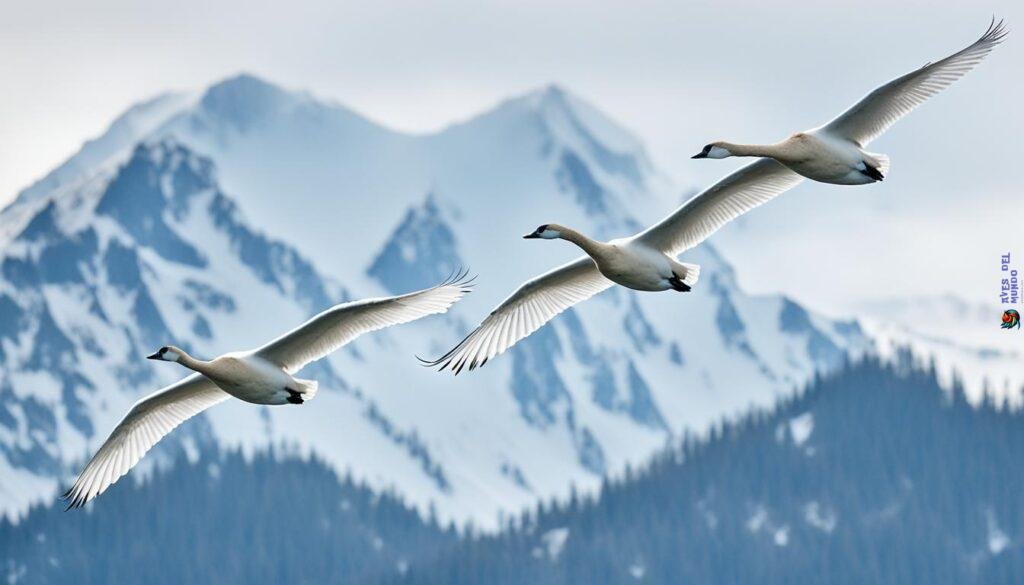
The Start of the Migration Season: Timing and Preparation
The swans know it’s time to move when waters warm and lands thaw. Seeing them start their migration means a lush season is near. It’s a natural sign of change.
Facing the Elements: Weather Conditions during the Migration
The swans face tough weather on their trip. They deal with cold and snow as they fly high. Their journey shows us the strength of life on the move.
Key Resting Areas Along the Migratory Bird Routes
There are special places where swans rest on their trip. These spots are where you can see them up close. Knowing these places is great for wildlife enthusiasts.
Physical Hardships on Bird Watching Migration Trails
When you start watching the epic journey of birds migrating, you realize it’s full of challenges. These challenges test the birds’ limits. Understanding how species like the Trumpeter Swan migrate shows us their amazing strength and will.
Navigating Rough Terrain: Mountains, Deserts, and Water Crossings
Think of the different terrains birds cross during migration. They face tall mountains, which are hard to get over and test their strength. Deserts are vast and have little water, making them tough to cross. Water bodies are risky too, with unpredictable conditions.
The journey of bird migration is proof of nature’s demands. It shows how birds need to adapt and be strong to survive.
Energy Depletion and the Need for Safe Foraging Zones
Birds migrating, like the Trumpeter Swan, use a lot of energy. Thus, finding places to eat and rest is key to their survival. These stops help them get ready for the next part of their trip. Keeping these stops safe is crucial for all migrating wildlife.
We often overlook the complexity of bird migration. Let’s appreciate the strength of these birds who make this tough trip every year.
| Terrain Type | Challenges | Impact on Migration |
|---|---|---|
| Mountains | Altitude, thin air, unpredictable weather | Oxygen scarcity and weather delays |
| Deserts | High temperatures, lack of water | Greater energy depletion, heat stress |
| Water Crossings | Strong currents, limited rest spots | Increased risk of exhaustion and predation |
Birds show great adaptability in facing these challenges. They highlight the close connections in wildlife migration patterns. And they show the resilience needed to complete this tough journey.

The bird migration cycle is a remarkable part of nature. It shows the fierce spirit of these animals. It also highlights our role in protecting their migration paths for the future.
Challenges of Navigation and Distance in North America Bird Migration
Trumpeter Swans face big challenges on their North America bird migration journey. They travel long distances across the continent, following an migratory birds routes system developed over thousands of years. Their amazing ability to navigate these routes shows their skill and adaptability.
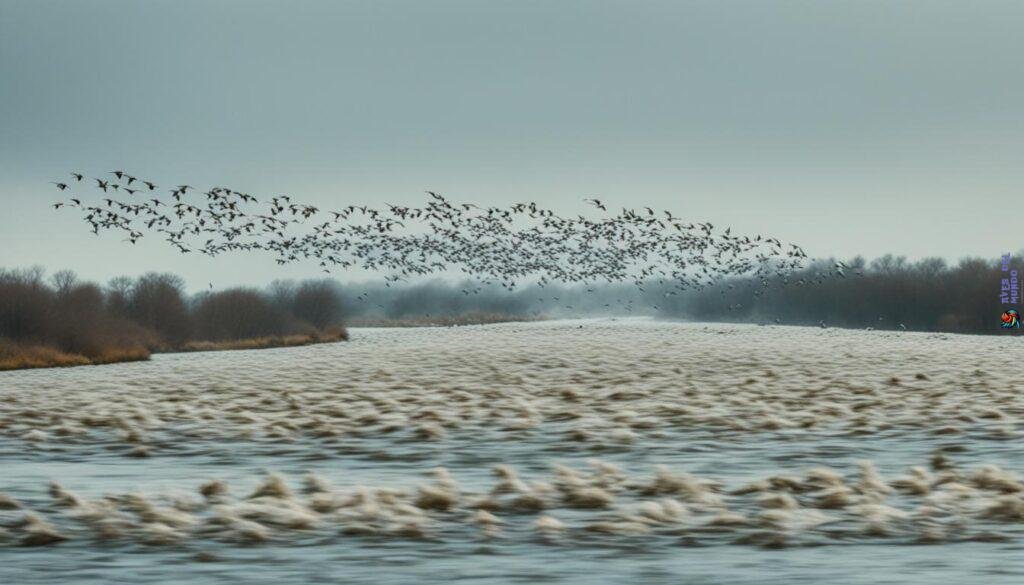
During their incredible journey, their natural sense of direction is key. But learning from their environment and flock is also crucial. We explore what drives them to undertake such a significant journey across North America.
| Key Influencing Factors | Description |
|---|---|
| Innate Sense of Direction | Genetically encoded navigation skills that guide the birds through familiar and unfamiliar territories. |
| Landscape Features Recognition | Visual identification of mountains, rivers, and other natural landmarks serving as waypoints. |
| Weather Patterns | Interpreting atmospheric cues like wind direction and barometric pressure to optimize the journey. |
| Learned Behaviors | Knowledge passed down through generations, adjusting flights based on collective experience. |
| Flock Dynamics | Grouping strategies to enhance aerodynamics and provide safety in numbers on long flights. |
| Magnetic Field Sensitivity | Ability to sense Earth’s magnetic field for orientation during the migratory journey. |
Trumpeter Swans rely on their advanced skills to navigate the bird migration route. As seasons and landscapes change, they adapt, led by natural forces. Witnessing a North America bird migration reminds us of the deep connection between these birds and their migratory birds routes.
Wildlife Migration Patterns: Adapting to Environmental Changes
We must understand how growing environmental issues are changing wildlife migration. This includes species like the Trumpeter Swans. The balance of these migrations is threatened by climate change and human actions. It’s crucial we take action for conservation.
Impact of Climate Change on Habitats and Food Sources
Climate change shifts habitats and food for migratory animals. As weather gets unpredictable, Trumpeter Swans face new challenges. This affects not only birds but many migratory species, linked to climate health.
These animals may change when they leave, their paths, or where they’re going. But these changes have limits, showing how fragile their migration is.

Human-made Barriers and the Need for Conservation Efforts
Humans have changed the natural world, creating obstacles for migrating animals. New developments cut through migration paths. This makes it hard for species like birds to migrate as they used to.
«As natural pathways are blocked by cities, and untouched areas are divided, it becomes clear we need strong conservation work.»
To keep migration patterns alive, we need new plans and fast action against climate change and human barriers. This could mean protected routes, strong climate policies, or fixing damaged habitats. We have to act quickly.
| Migration Challenge | Conservation Response |
|---|---|
| Altered habitats due to climate change | Establishment of climate-resilient sanctuaries |
| Decreased food availability | Implementation of sustainable agriculture practices |
| Infrastructure disrupting migratory routes | Development of wildlife overpasses and underpasses |
| Climate-driven extreme weather events | Enhanced meteorological forecasting and responsive migration management |
Swan Migration Season: The Race Against Time
The swan migration season is a time-sensitive natural event. Trumpeter Swans journey across the bird migration route facing many dangers. They travel with great precision. Their timely departure is crucial for breeding and raising their young successfully.
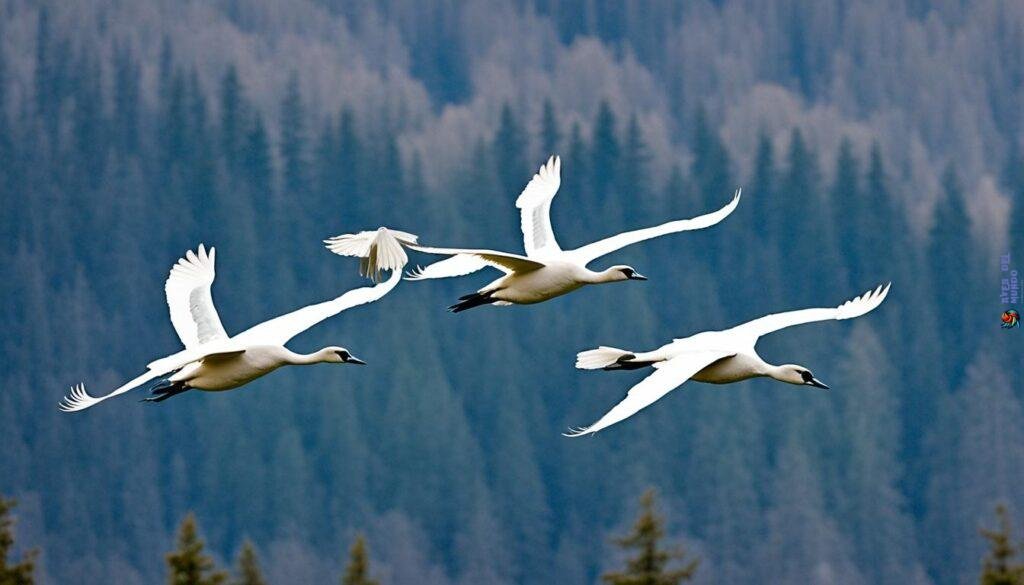
Following their migratory birds routes, swans race against time. Each wingbeat moves them closer to their goal. Even small delays can cost them food and mating chances.
Observers see the detailed nature of their trip. Swan migration shows the birds’ resilience and determination. Arriving on time ensures their family line continues and their migration paths remain.
Their harmony with nature is key to their survival. Recognizing this urgent race highlights the need for conservation. Protecting their migratory birds routes helps these birds and future generations.
Understanding Bird Migration Routes: The Science Behind the Patterns
As spring arrives, many migratory bird species start their amazing trips. Scientists use research techniques to study bird migration routes. Their work helps us understand more and helps protect these birds during their journeys.
![]()
Research Techniques for Tracking Bird Movement
Researchers now have new tools to explore bird migration patterns. They use banding, satellite tracking, and careful observation. These methods help us learn about birds like the Trumpeter Swans, who travel far and wide.
| Technique | Utility | Data Provided |
|---|---|---|
| Bird banding | Long-term monitoring of individual birds | Migratory birds routes, lifespan, survival rates |
| Satellite tracking | Real-time movement tracking over large distances | Detailed migratory paths and speed of travel |
| Field observations | Behavioral study in natural habitats | Feeding patterns, resting habits, social interactions |
The Role of Innate Behavior and Learned Routes in Migration
Learning how migratory birds find their way is fascinating. Many routes are written in their genes. This helps them cross unfamiliar vast lands. Plus, they learn from each migration, making future travels even sharper.
Predation and Competition: Survival Challenges for Migratory Birds
When we dive into the world of migratory birds routes, we see their journey is full of challenges. These birds, like the majestic Trumpeter Swans, travel far. They face dangers from predators and battles for food with other species. These challenges are essential parts of their long journey’s story.
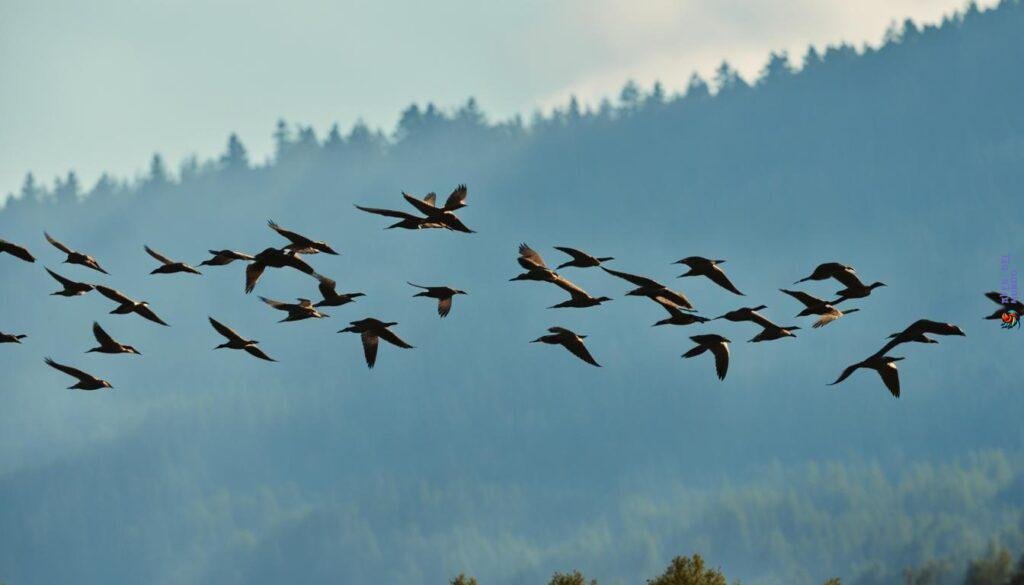
Defending Territory: Interactions with Local Species
Migratory birds often fight for territory when they reach new places. The local birds don’t welcome them because they too need resources to survive. Understanding these fights is important. It shows us how migratory birds find food and safe places to rest during their trip.
The Threat of Predators on the Journey
Predators are a big risk for traveling birds. This danger shows how tough birds need to be to migrate. Birds, including the Trumpeter Swans, must always be careful. They face many dangers, not just from the land and sea, but also from predators waiting to catch them.
The idea of predation and competition for food highlights how strong migratory birds are. Their survival comes from their smart strategies and natural instincts. These help them face their journey’s challenges and continue the cycle of migration across our skies.
Human Interaction and Its Impact on Migratory Birds
When you hear the Trumpeter Swan’s call, it means a grand migration has started. The Trumpeter Swan Migration is an awe-inspiring sight. Yet, it faces threats from human activities. Buildings, roads, and farms often cross migratory birds routes. This makes their journey harder. Loss of wetlands to farms takes away crucial resting spots. City lights and power lines are dangerous obstacles in their path.
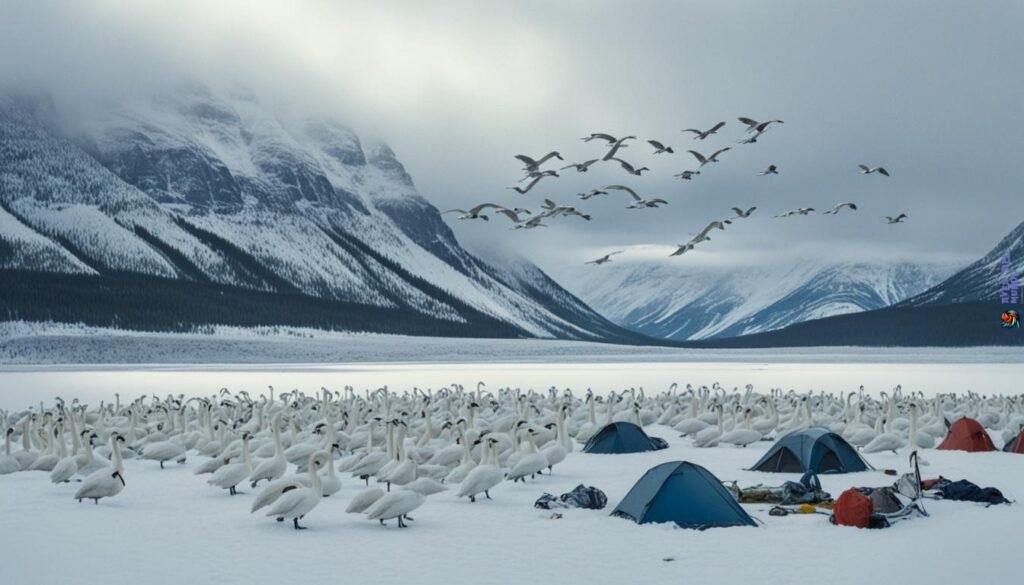
Conservation efforts are crucial in facing these challenges. They act as vital supports for our ecosystem’s balance. By protecting migration paths, securing habitats, and raising awareness, we lessen the negative effects of human interaction. The Trumpeter Swan travels thousands of miles. This incredible journey urges us to think about our actions and the importance of living together in harmony.
Conservation in Action:
- Advocating for legislation that safeguards migratory bird habitats
- Supporting land preservation through organizations and private sanctuaries
- Participating in citizen science programs to track and monitor swan populations
- Reducing individual and collective carbon footprints to combat climate change
As we admire migratory birds’ toughness, let’s remember our role in their story. Through our active involvement, we can ensure that The Trumpeter Swan Migration remains a beautiful event in our world for many years.
The Future of Bird Migration: Predictions and the Importance of Conservation
Looking to the future, it’s vital to focus on conservation for The Trumpeter Swan Migration and all wildlife migration patterns. Changes in climate, habitat, and human activity pose big challenges. These could change bird migration patterns as we know them. So, protecting our ecosystem is a must, not just a kind action.
To predict bird migration, we need research, technology, and working together globally. Conservationists are hard at work. They study species like the Trumpeter Swan. They aim to tackle environmental and human impacts. Your support helps protect these important bird journeys. This keeps our natural world healthy.
We must keep these amazing journeys going as earth’s caretakers. Conservation efforts give migratory birds like the Trumpeter Swan the strength to face new challenges. Our job is to ensure bird migration continues for future enjoyment. By focusing on conservation now, we shape future stories of our environment.
